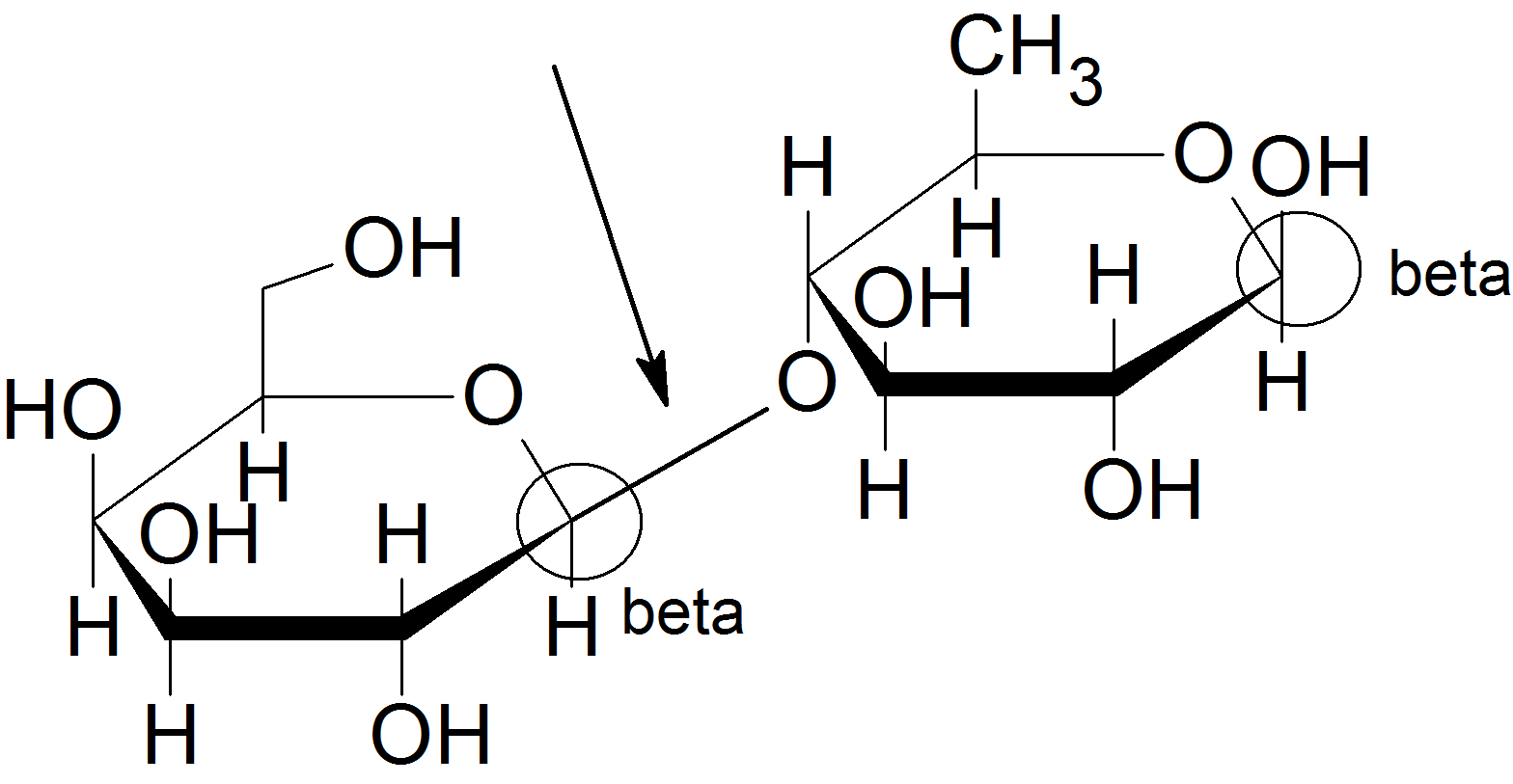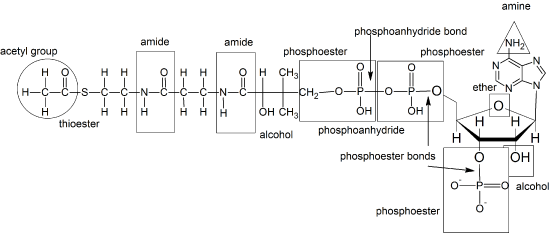18: Homework Solutions
- Page ID
- 43953
Carbohydrate Catabolism
(01)

a. The enzyme lactase catalyzes the hydrolysis of lactose into galactose and glucose.
b. disaccharide.
c. see above
d. See above; beta-(1,4)
e. beta-D-galactose and beta-D-glucose
(02) Polysaccharides are hydrolyzed to monosaccharides, primarily glucose. During glycolysis one glucose is oxidized to two pyruvate "molecules*" producing 2 ATP and 2 NADH. Pyruvate is oxidized to acetyl CoA which enters the citric acid cycle (CAC) to produce 1 GTP (ATP equivalent), 3 NADH, and 1 FADH2. The reduced coenzymes transfer two of their electrons to the electron transport chain followed by oxidative phosphorylation to produce additional ATP (3 ATP / NADH and 2 ATP / FADH2). *The molecule pyruvic acid is ionized at pH 7.4 to pyruvate.
(03) Nerve cells and mature red blood cells rely on glycolysis for energy production because it can occur in the cytosol of the cell and does not require mitochondria.
(04) anaerobic (without oxygen): pyruvate is converted to lactate which does not procede to the next stage of metabolism.
aerobic (with oxygen): pyruvate is converted to acetyl CoA which can then enter the Citric Acid Cycle (CAC)
(05) The primary biochemical role of carbohydrates is energy.
(06) Breakdown of ATP to ADP occurs during steps 1 and 3 of glycolysis. Building up ADP into ATP occurs during steps 7 and 10 of glycolysis.
(07) The phosphate group (Pi) is transferred from phophoenolpyruvate to ADP to from ATP. The alkene and phosphoester of the substrate (phophoenolpyruvate) become an alkane with a ketone.
(08) The first stage is glycolysis which produces 2 molecules of pyruvate which can be converted to acetyl CoA under aerobic conditions. In the second stage, acetyl CoA enters the Citric Acid Cycle to reduced coenzymes. In the third stage, the reduced coenzymes enter the electron transport chain with oxidative phosphorylation to produce 32-36 ATP overall.
Fatty Acid Catabolism
(09) The triglyceride mixes with bile salt so that it can come in contact with the lipase enzymes and undergo hydrolysis to produce glycerine and three fatty acids. Each fatty acid undergoes beta-oxidation to produce acetylCoA and NADH. for an n-Carbon fatty acid, there are n/2 molecules of acetyl CoA produced and (n/2 -1) molecules of NADH. The acetyl CoA enters the citric acid cycle (CAC) to produce 1 GTP (ATP equivalent), 3 NADH, and 1 FADH2. The reduced coenzymes transfer two of their electrons to the electron transport chain followed by oxidative phosphorylation to produce additional ATP (3 ATP / NADH and 2 ATP / FADH2).
(10) Fatty acids are obtained from eating fats and oils. Fats and oils are triglycerides. The hydrolyis products from triglycerides are glycerine and fatty acids in a 1:3 ratio. Fatty acids are not consumed directly from our food.
(11) Lipoproteins are spherical lipid-protein complexes that transport hydrophobic triglycerides (fats and oils) through aqueous body fluids because they are not water soluble. Chylomicrons transport lipids. Serum albumin transports fatty acids from storage in adipose tissue. VLDLs (Very Low Density Lipoproteins) transport triglycerides synthesized in the liver. LDLs transport cholesterol synthesized in the liver. HDLs (High Density Lipoproteins) transport cholesterol from dead cells.
(12) The polar head is oriented out toward the aqueous body fluids to create water solubility. The non-polar tails are oriented into the center to solubilize the triglycerides. The higher the ratio of protein the higher the density of the lipoprotein. HDLs have the highest density and contain the highest ratio of protein to lipids. Chylomicrons have the lowest density and contain the lowest ratio of protein to lipids.
(13) Mitochondria
(14) Once the activated fatty acid enters beta-oxidation, it undergoes 4-steps: redox → hydration → redox → acyl transfer. Yes, there are 2 redox reactions.
Acetyl Coenzyme A and the Citric Acid Cycle
(15) anabolic = build up smaller molecules into larger ones and require energy
catabolic = break down larger molecules into smaller ones with an overall production of energy
(16) Acetyl CoA produced from catabolism. All three major dietary biomolecules (proteins, carbohydrates & lipids) can contribute to the production of acetyl CoA.
(17)

(18) (a-d) Citrate and isocitrate are structural isomers. They have the same chemical formula but different bonding arrangements.

(19) The carbonate groups leave as CO2. NAD+ is the oxidizing agent. Two NADH molecules are produced by the end of step 4.
(20) From start to finish, three NADH and one FADH2are produced durng one turn of the CAC.
(21) 3 ATP from 1 NADH and 2 ATP from 1 FADH2
(22) Steps 3 and 4
Citric Acid Cycle
(23) a. redox
b. oxidized
c. reduced
(24) a. hydration
b. Yes, the product has one chiral carbon.
(25) An acyl transfer reaction converts oxaloacetate to citrate and acetyl-CoA to CoASH.

(26) Negative enthalpy means exothermic. The word "heat" would be added to the product side because heat is released during the reaction.
Oxidative Phosphorylation
(27) Mitochondria are the cellular organelles responsible for facilitating energy production. Beta-oxidation of fatty acids, the citric acid cycle, the electron transport chain, and oxidative phosphorylation all takes place in the mitochondira.
(28) Glycolysis takes place in the cytosol (cytoplasm) of the cell. Glycolyisis is catabolic.
(29) The inner membrane is semi-permeable.
(30) The protons (H+) are pumped into the inter-membrane space of the mitochondria resulting in a lower pH.
(31) The proton concentration [H+] gradient across the inner membrane of the mitochondria stores potential energy. It is similar to a battery because they both have stored chemical energy.
(32) CN- irriversiblly binds to the cytochrome a3 in Complex IV of the ETC which stops the ability to produce ATP.
(33) CoQ and Cytochrome c are the mobile electron carriers of the ETC. CoQ moves electrons from Complex I to Complex III and from Complex II to Complex III. Cytochrome c moves electrons from Complex III to Complex IV.

